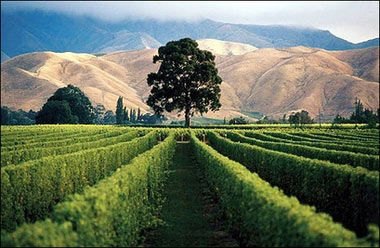A wine with a whiff of "cat's pee on a gooseberry bush"
has transformed Marlborough's Wairau Valley from scruffy farming country into
New Zealand's wine capital in just three decades.

This
undated handout from Pernod Ricard (PR) shows Montana Wines Stoneleigh
vineyard in the Marlborough region in the northeast of New Zealand's South
Island. Stoneleigh is one of the best known brands associated with
Marlborough's production of sauvignon blanc wines, the flag bearer of New
Zealand's wine exports.[AFP] |
The sauvignon blanc grape has been the making of New Zealand's wine industry
and especially of the largest winemaking area Marlborough, which lies at the
northeast tip of the country's South Island.
The pungent wine divides drinkers and critics but its unique racy character
has won a legion of fans in Britain and more recently the United States.
For the record, the "cat's pee on a gooseberry bush" description -- usually
attributed to British wine critic Oz Clarke -- was a compliment.
The wide Wairau Valley floor is carpeted in vines as far as the eye can see,
to the bald brown Wither Hills on the eastern side and the Richmond Range to the
west. Little suitable land is left and new vineyards are spreading into the
nearby Awatere and Waihopai Valleys.
The pioneering company in the region was Montana, which planted "a fruit
salad" of varieties in 1973 to see what prospered.
In the pubs of Blenheim, the main town of the region, many of the locals
scoffed over their beers at the idea that grapes could be grown successfully on
the frost-bitten South Island.
"Nobody ever grew citrus or anything that was slightly frost-sensitive on
this side of the Cook Strait (which divides New Zealand's main islands), so
growing grapes was considered a joke," says winemaker Allan Scott.
Scott worked for Montana planting the first vines in Marlborough -- most of
which died in a drought the following summer -- and these days he heads a
successful family winemaking business.
The introduction of irrigation secured the future of the industry and most of
the scoffing farmers have either taken up grape-growing themselves or sold their
land to grape growers at a fat profit.
The first sauvignon blanc vines in Marlborough were planted in 1976, and
Montana's national wineries manager Gerry Gregg says the first crop left
winemakers scratching their heads.
"When the grapes came through to the winery it was, 'Wow, what do you do with
that,'" he said of the pungent juice.
By the mid-1980s Marlborough sauvignon blanc, particularly that of newcomer
Cloudy Bay, caught the attention of several British wine writers -- and the rise
of Marlborough Sauvignon Blanc was under way.
"It's been one of those dream successes which doesn't come up in many
people's lifetimes," Gregg says.
A walk through Montana's winery gives you some idea of what that success
means. Row upon row of stainless steel tanks holding up to 55,000 litres of wine
is a world away from the traditional artisan image of winemaking.
Montana, which is now owned by French drinks giant Pernod Ricard, has 2,200
hectares of vineyards in Marlborough, just over a tenth of the region's total.
The sauvignon blanc harvest -- around 85 percent of which is grown in
Marlborough -- amounted to 96,000 tonnes nationally.
Demand for sauvignon blanc wines in New Zealand appears to be flattening off
but foreign markets -- which in the year to June 2005 took 50 million litres of
New Zealand wine or over half of total production -- still cannot get enough.
"The US is desperate to get sauvignon blanc, it's just scary stuff," says
Scott.
"I can't see an end to it. There must be an end to it, but I can't see it in
the short term."
Daniel Le Brun, a native of a village near Epernay in France's Champagne
region, has no time for Marlborough's signature wine at all.
"To me it is an idiosyncrasy. It has become such an icon of New Zealand wine,
when to me it is young, green and nasty," Le Brun says in his small Wairau
Valley winery.
Marlborough is trying to prove it is no one-trick pony and has had success
with fruit-driven chardonnay and riesling wines -- and more recently with the
red pinot noir variety, the rising star of New Zealand wine.
Le Brun has dedicated himself to using the champagne-making skills honed by
12 generations of his family in France to produce top quality sparkling wines in
Marlborough.
Disillusioned with the difficulty in buying land in his native Champagne, Le
Brun moved to New Zealand to become another of the Marlborough winemaking
pioneers in the late 1970s.
The path to success has been strewn with obstacles, learning by trial and
error to overcome the local peculiarities of climate and soil. Having mastered
those, he was forced out of his first company Cellier Le Brun 10 years ago by
outside investors and now the company bearing his name is his rival.
Le Brun's new company is the No. 1 Family Estate and he is adamant he will
not be taking on any outside investors.
He makes only three methode champenoise wines -- the name champagne cannot be
applied to anything made outside the region in France -- and after 30 years and
many awards, he says his decision to plant himself in Marlborough has been
vindicated.
"I really believe outside France, New Zealand in general and Marlborough in
particular has to be the best place to produce methode champenoise. There's not
a shade of doubt," he says emphatically.